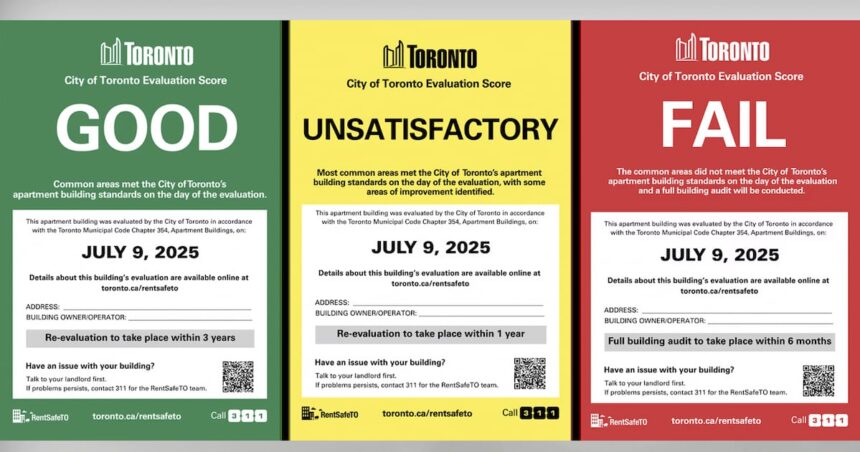The halls of Toronto City Council echoed with decisive action yesterday as councillors voted overwhelmingly to implement a colour-coded rating system for apartment buildings across the city—a landmark decision poised to transform how tenants evaluate potential homes and how landlords maintain their properties.
By a commanding vote of 22-2, council members approved the implementation of a DineSafe-inspired system that will assign clear ratings to buildings with 10 or more units or three or more stories. The ratings—ranging from green for compliant buildings to yellow for conditional passes and red for those failing to meet standards—will be prominently displayed in building lobbies, providing immediate transparency for current and prospective tenants.
“This is about giving renters the information they deserve,” Councillor Josh Matlow, the driving force behind the initiative, told CO24 News. “For too long, tenants have been forced to make life-altering housing decisions without knowing the true conditions of buildings they’re considering. Today, we’re changing that power dynamic.”
The system extends beyond mere visual cues. Buildings will receive scores between 0-100, with detailed inspection reports available through a searchable online database. These reports will document everything from pest infestations to elevator functionality, providing comprehensive insights into building conditions.
Mark Richardson, technical lead for HousingNowTO.com, praised the decision while speaking with CO24. “This represents a fundamental shift in accountability. When potential renters can see exactly how a building performs on health and safety measures, landlords will be incentivized to address issues promptly rather than allowing them to linger.”
The Federation of Metro Tenants’ Associations has similarly lauded the move, calling it “a crucial step toward tenant empowerment” in Toronto’s challenging rental market. With vacancy rates hovering around 1.5% according to the latest Canada Mortgage and Housing Corporation data, renters often feel pressured to accept substandard conditions due to limited options.
Implementation won’t happen overnight. City staff will develop the program over the coming months, with a phased rollout expected to begin in 2025. The system will initially focus on older rental buildings before potentially expanding to include condominiums and other multi-unit dwellings.
The financial implications remain modest, with program costs estimated at $1.1 million annually—funds that will support building evaluations and maintaining the public database. This investment represents less than 0.01% of Toronto’s annual operating budget, a small price for what advocates describe as a transformative transparency initiative.
Predictably, some property management organizations have expressed reservations. The Greater Toronto Apartment Association voiced concerns about potential “unfair stigmatization” of buildings and questioned whether the system adequately accounts for ongoing improvement efforts.
Councillor Stephen Holyday, one of two dissenting votes, echoed these sentiments during council deliberations. “We already have robust property standards enforcement. I worry this system oversimplifies complex building management realities and could inadvertently reduce housing supply if buildings are unfairly labeled.”
However, tenant advocates point to the city’s existing RentSafeTO program, which has documented persistent issues in numerous buildings despite current enforcement mechanisms. They argue the new rating system simply makes already-collected information more accessible and understandable to the public.
As Toronto continues grappling with its housing crisis and aging rental stock, this initiative represents a significant shift toward transparency in the rental market. The question now becomes: will this newfound accountability meaningfully improve living conditions for the nearly half of Toronto residents who rent their homes, or will it simply highlight problems without addressing their underlying causes?
























